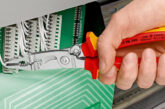
Need help with cracking those EICR codes? The technical team at NAPIT, with the help of the 18th Edition Codebreakers publication, answer your latest coding queries. Click on the photos for a closer look!
HAMMOND ELECTRICS: THIS WAS FOUND RECENTLY ON A SUMMER HOUSE. THE MAIN EARTH WAS IN A BREAKER AS IT DIDN’T FIT IN THE TERMINALS PROVIDED, BUT WAS SWITCHED OFF AND WASN’T CONNECTED TO THE BOARD ITSELF, SO THERE WAS NO EARTH AT ALL!
There are a couple of issues here, so I’ll start at the top and work down. Firstly, we have the supply conductors and cpc entering a ferrous enclosure through separate openings, which may lead to heat build-up issues in the surrounding enclosure by eddy currents. Although this is a ‘shall not do’ from a BS 7671 perspective, we must understand that BS 7671 isn’t a purely domestic document; it covers many aspects in its scope.
Generally speaking, eddy currents don’t tend to become problematic until the load current is in excess of 100-125 A continuously. In a domestic scenario, it’s unlikely we’ll see too much of an issue on lightly loaded circuits or short-duration high loads. That said, it has to be coded, so without signs of thermal damage and with a low-load design signature, it’s unlikely to be an issue. If thermal damage were present, we’d need to up the coding severity.
Secondly, and possibly the most dangerous, is the switched overcurrent protective device (OCPD) placed in the cpc via an MCB. This is incredibly dangerous from both the switching element and the fusing element. Fusing in cpcs is not allowed, and switching is only allowed for specific reasons under stringent design factors using devices that simultaneously disconnect all live conductors and the cpc, such as may be required for alternative supplies. Both of these have significant potential for danger and harm. We’ll overlook the failure to correctly mount the MCB on a din rail, as the device isn’t supposed to be there!
Thirdly, the load and supply sides of the switch have been connected the wrong way around. Although this won’t cause an issue in day-to-day operations, the load-side terminals will be live when the switch is isolated. Likewise, the fuse carrier terminals may give access to parts that would normally be de-energised when the switch is in the off position, and the fuse carrier is swung out to replace the fuse. This kind of poor installation practice has the potential to cause harm if an item is expected to be de-energised and then turns out to be live.
There are also a couple of issues with the adequate marking of the SWA conductors, which also need to be addressed.
 Order your copy of NAPIT Codebreakers here
Order your copy of NAPIT Codebreakers here








